| Nikon D3 Digital Camera Reviewed |
|
|
| by Bjørn
Rørslett |
|
9. D3
against the D300: FX vs DX format
Nikon has stubbornly endorsed
their "DX" format as the better approach to digital SLR
for a long time. They advocate the smaller-sized imager as being
the optimal solution for cameras compatible with existing 35 mm
cameras and lenses. Other companies, namely Canon and Kodak, have
pursued other avenues and designed "full-frame" (FF)
cameras. There is a wide-spread belief that "FF" is not
only desirable, but necessary to achieve top performance for
"35mm" DSLR models. With the entry of the new top
model, D3 and its FX format, time has finally come to make
qualified statements about the wisdom of Nikon's earlier DX-based
policy.
I chose to make the comparison
with D3 and D300, since they both are 12 MPix models. Intially I
thought of using the D2X as the alternative, but since a write-up
on the D300 is on my to-do list, I selected the latter model.
Admittedly, a fair comparison of these cameras is a tall order.
Fields of view are quite different of course, so are angular
resolution due to pixel pitches and pixel density. Amongst these
two, D3 has the biggest pixel pitch and the lowest pixel density,
D300 the opposite. The frame ratio aspects of the cameras are
slight different too, but close enough to 1:5:1 to have no
significance for my assessments.
Among the claims laid down in
favour of either format are finder size, sharpness,
depth-of-field (DOF) considerations, "reach" of longer
lenses, a "speed" advantage, vignetting behaviour,
noise performance, dynamic range, pricing, and size/weight. Since
a D2X/Xs (DX) is the same size and heft as the D3 (FX), we rule
out the latter directly. The inherent cost of the systems as they
now appear would appear to go in favour of the DX, but since
Nikon's FX is only just embarking its development this situation
could change in the near future. However, all things considered a
bigger sensor chip will always cost more than a smaller one. In
terms of noise, or rather, a better high-ISO performance, Nikon
has provided the answer by equipping D3 with 6400 ISO as the
highest calibrated setting plus giving boosted values up to 25600
ISO (equivalent), whilst the D2X/Xs went up to 800 ISO (3200 ISO
equivalent boosted), and the D300 is rated up to 3200 ISO (6400
ISO equivalent boosted). The recent crop of DX-format cameras
exemplified by the D300 has come a long way towards giving us a
better, bigger, and brighter, finder, but undeniably the D3 FX
has the upper hand in this department.
In terms of sharpness, pixel
density has to be factored into the equation. Thus, given that
the D300 has the (approx.) equal number of pixels as the D3, but
packed into the half area, it is obvious that D300 potentially
can record finer detail. Whether it does come out on top depends
on the subject, though. I've seen examples of either camera
delivering the "best" image under field testing
although the tendency is for the D300 to have the upper hand. But
since theory supports the notion that DX potentially can be
sharper than the (current models of) FX, I accept this as a fact
for now. However, in order to realise the better sharpness
potential, you need to be able to focus more accurately and this
requirement is not entirely compliant with the finders on these
systems.
Whether you consider the
cropped DX format to give more "reach" will depend
entirely on how you perceive and deal with
"magnification" of a framed shot. Using a 200 mm on a
DX camera gives smaller magnification than a 300 mm on an FX from
the same position and distance to the subject, but you get almost
identical field of view. So the same 300 mm lens now deployed on
the DX camera will actually increase detail magnification (to the
same level as on the FX, of course), but the field of view is
smaller. Many would argue this constitutes a
"magnificaton", which at best is a direct abuse of
terminology. What is happening is that you have effectively
cropped away more around the subject. You could equally well use
the FX camera and trim the image later, so as to achieve a
"DX crop" by indirect means (but the pixel density will
be lower since the pixel pitch remains the same).
The alleged "speed"
advantage is closely associated with the depth-of-field (DOF)
considerations. The reasoning goes as follows: According to
current DOF models, with DX you can use a lens with focal length
(DX/FX) at 1 stop larger setting and achieve the same DOF
extension as on FX. Thus, using a 200 mm lens at f/2 on DX will
result in the same DOF (and field of view) as a 300 mm lens at
f/2.8 with the FX camera, if both are shot with the same distance
to the subject. It's pretty obvious that the
"advantage" depends on which camp you consider yourself
being a member of. You could twist the argument and say that DX,
given that the assertion above holds, will allow you shorter
exposure times since you don't need to stop down to the same
degree. The entire claim also hinges on the (rather dubious)
assumption that the end user won't see a difference in how an FX
camera is used compared to a DX system. But for now, we just take
this assumption as a parameter to the sequence following.
Much of the debates that one
observes flare up on the Internet forums come from people heaping
upon their opponents arguments from DOF calculators. Now,
"DOF" is not a physical property, it is something
perceived and processed by the human mindset, and it is very much
an elusive quantity as well. Most DOF models are based upon
image-forming geometry, plus assumptions about the viewing
conditions to which the final image is subjected. All of these
parameters may be physically modelled with high precision yet
this tells nothing of the concordance between what is modelled
and what can be observed. Thus, typically the image won't clearly
break into "sharp" and "unsharp" areas with a
distinct border between them, rather there will be zones of
increasing sharpness (or unsharpness if you prefer going the
opposite direction). Where to draw a line and say
"inside" or "outside" a DOF zone is very
subjective. Digital images are essentially dimensionless until
they are outputted as something tangible, like a print hanging on
a wall. Thus, while we can envision the primary stage of optical
magnification, namely, the size of the details projected onto the
imager, it is more difficult to understand the rôle and amount
of secondary magnification (the enlargment stage that only can
make detail bigger, but not adding more information on its own).
Added complications are the pixel density and pixel pitch, which
both interact to limit spatial resolution of the captured image.
My first series of FX/DX DOF
comparison were conducted in the field using fairly long lenses,
such as 1200/800, 300/200, or 125/85, applied to landscapes.
While one might have an indication of differences, the actual DOF
for such shots is great enough to make the delineation of sharp
vs unsharp zones quite difficult, not to say a little
meaningless. I have posted some of these observations earlier and
the interested parties can consult them here.
In the FX/DX comparisons
following below, I tried to do a precisely defined setup that
could clarify differences FX/DX in more detail. I availed myself
of the fact that the 70-180 mm Zoom-Micro-Nikkor has its nominal
and effective aperture similar along its focusing scale. This
makes for elimination of potentially additional error since we
can use the same lens for either format and we are certain that
the apertures are compatible. I set up the test with a target
oriented precisely at 45° to the lens
and shot at a distance of 0.72 m with the Micro-Nikkor set to 122* mm and
180 mm for DX and FX formats, respectively.
*
although the EXIF reports 122 mm, I had the exact field of view
for both formats so the actual length should be very close to 120
mm. It seems the focal lengths reported by the 70-180 are not
continuous but have discrete steps, so one could either get 116
mm or 122 mm, but not 120 mm although the lens was set between
these two values.
First we test the basic
hypothesis that the format as such doesn't influence the depth of
field when the final magnifications give the same apparent size
of details. I have given supporting evidence for this earlier but
it doesn't hurt to repeat the test with a different experimental
layout.
| Crop of the centre area of each
shot, scaled to match precisely the D3 image at 100%
(actual pixel size) or approx. equal a print of 36 x 54
cm (@200 dpi). The focused point is the "15" cm
bar, and all focusing was conducted using LiveView at
maximum magnification. Flash (SB-800) used for lighting
the subject. NEF files processed in BibblePro 4.9.9b at
default settings and the crops of the TIF files from
Bibble converted to jpg in Photoshop |
Description of crop
(f=focal length, N=f-number, m=magnification) |
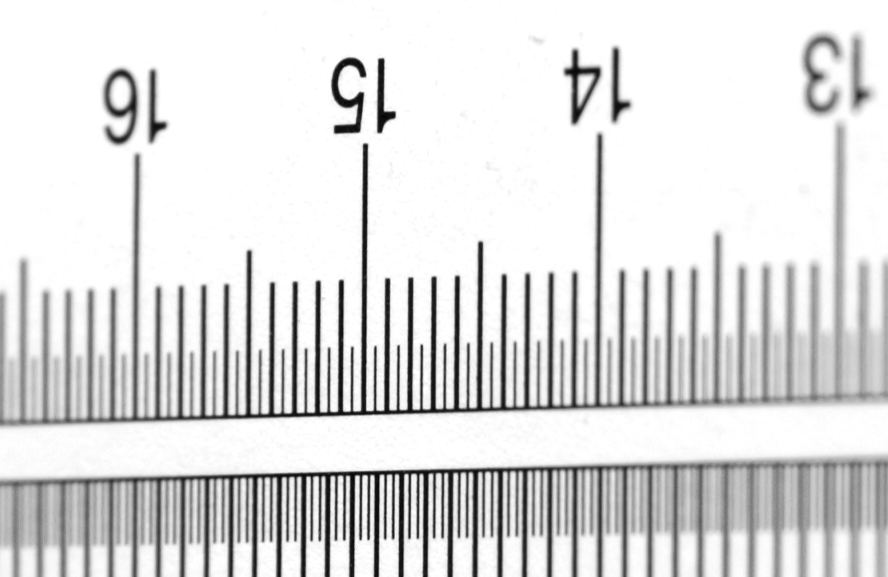
|
Reference
D3, FX frame
f = 180 mm,
N= 8,
m=0.2
Upper scale is in cm and has 45°
inclination to the optical axis. Thus, multiply any DOF
estimate read from this scale by 0.7 to get the
along-axis value
|
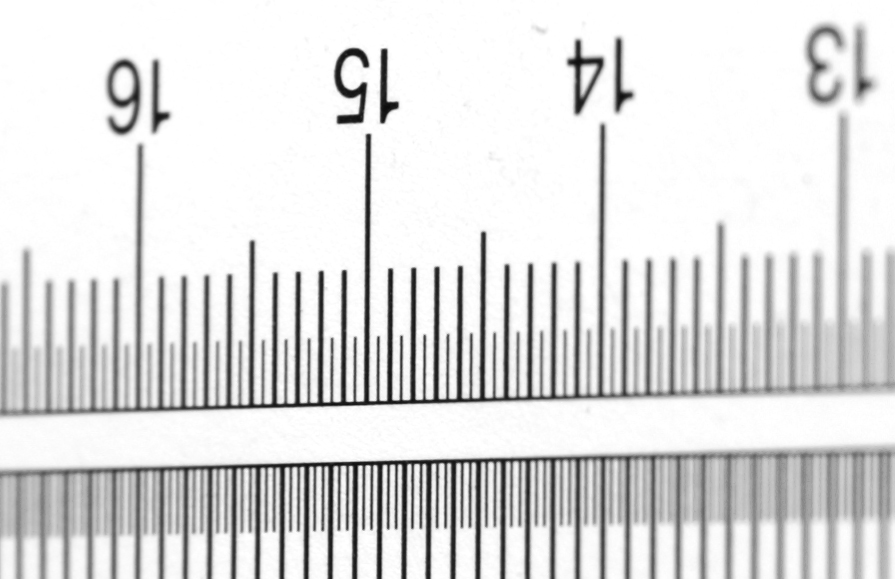
|
D3,
DX frame f=180 mm,
N=8,
m=0.2
|
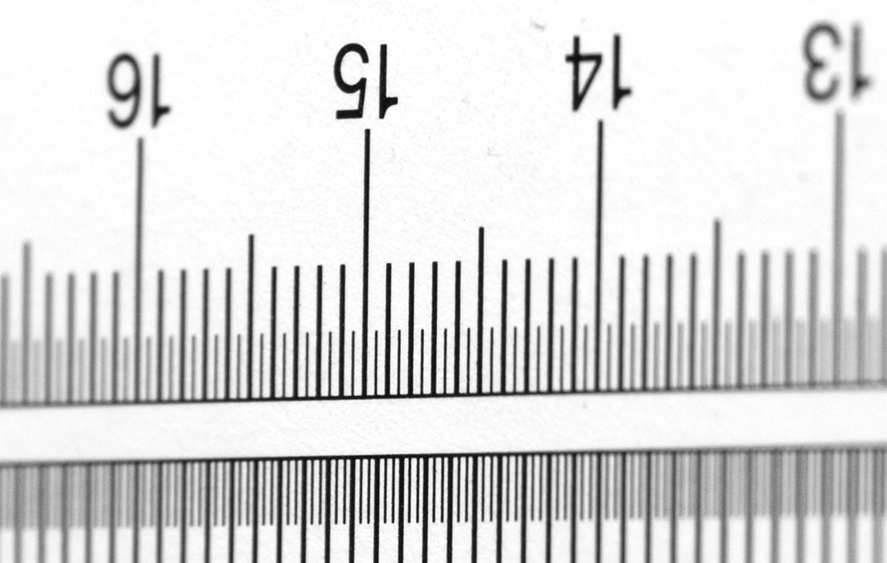
|
D300, DX frame
f=180mm,
N=8,
m=0.2
|
Does this comparison corroborate that using
the smaller "DX" format in itself will impact the depth
of field, a claim that so frequently is encountered? Honestly I
don't think so. Within the error of the experimental setup, all
crops appear to be identical in terms of their distribution of
detail sharpness. What we can observe, albeit just barely, is
that the lower pixel density (but identical pixel pitch) of the
DX mode of the D3 renders the final image just a tad less crisp
when it is brought to the same apparent size as the others.
In the case above, the primary
magnification (concerning detail at the film plane) is kept
similar. Now, we venture into the dire straits favoured by the
"equal FOV" fans. This is to say that you deliberately
put the smaller format at an disadvantage in order to make the
captured field of view identical. In this process, if we choose
to keep perspective equal, then picture angles will be different
and so will detail magnification by a factor of the ratio of
FX/DX diagonal (1.5 in this case). You could offset this drawback
by being able to open up 1 stop more so as to give a shorter
exposure time. All again per the parameter set I outlined
earlier. Now, let's check how reality fares against the
predictions.
| Crop of the centre area of each
shot, scaled to match precisely the D3 image at 100%
(actual pixel size). The focused point is the
"15" cm bar, and all focusing was conducted
using LiveView at maximum magnification. Flash (SB-800)
used for lighting the subject. NEF files processed in
BibblePro 4.9.9b at default settings and the crops of the
TIF files from Bibble converted to jpg in Photoshop. Note
that now we allow detail magnification to vary so as to
give the same field of view, but at different focal
lengths |
Description of shown crops |

|
Reference
D3, FX frame
f = 180 mm,
N= 8,
m=0.2
Upper scale is in cm and has 45°
inclination to the optical axis. Thus, multiply any DOF
estimate read from this scale by 0.7 to get the actual
value
|
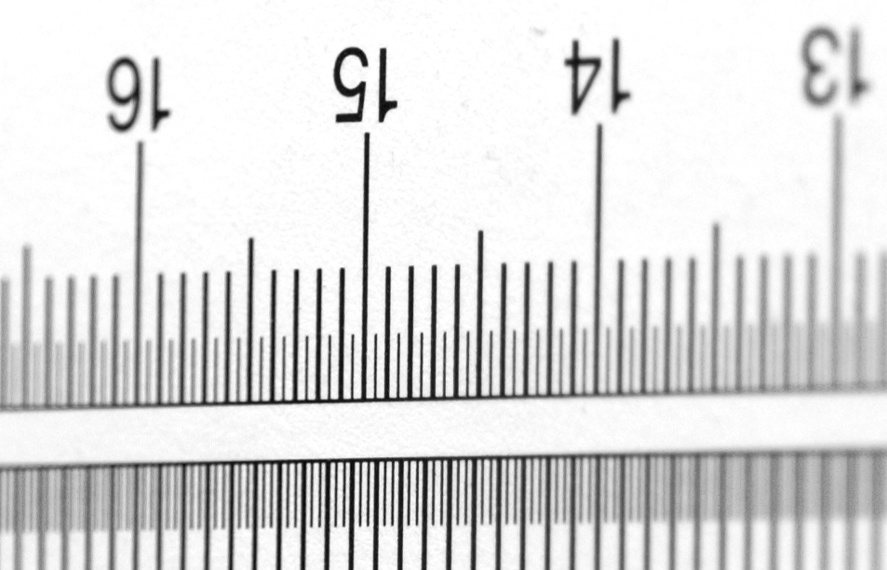
|
D300,
DX frame f=122 mm,
N=5.6,
m=0.13
|
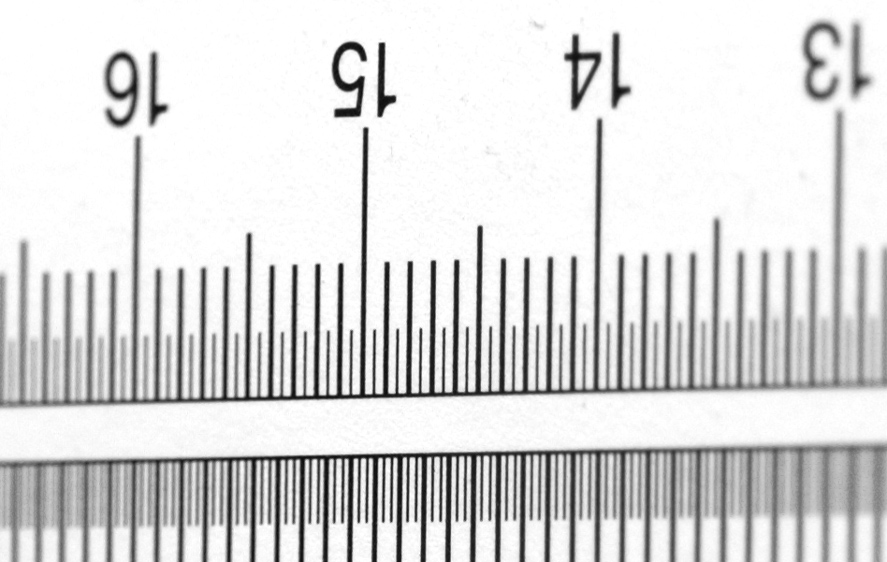
|
D300, DX frame
f=122mm,
N=6.3,
m=0.13
|
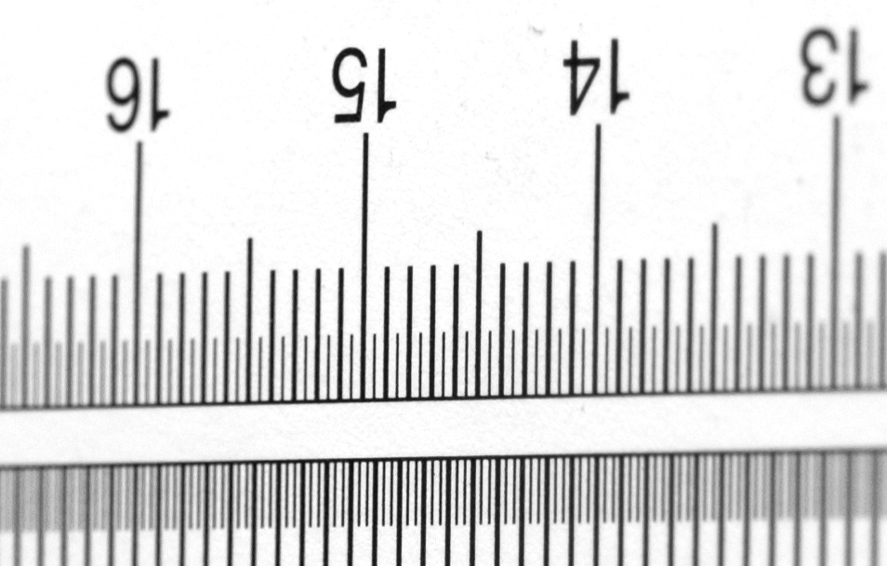
|
D300, DX frame
f=122mm,
N=7.1,
m=0.13
|
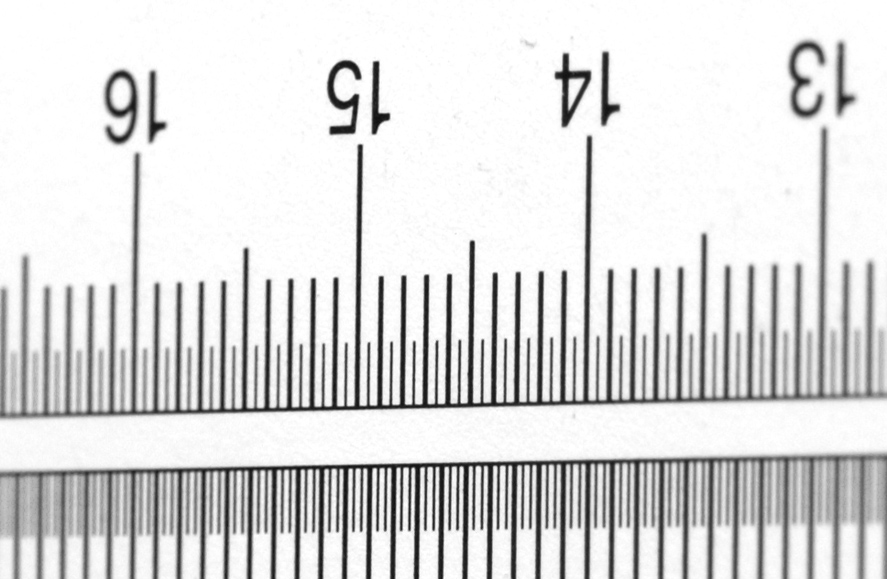
|
D300, DX frame
f=122mm,
N=8,
m=0.13
|
What can be learned from the panel above is
the stark real-life existence and behaviour of the
"DOF" issue. There is no such thing as "real"
phenomena which can be measured and plugged into a nice,
quantitative model. Essentially, perceived DOF is a qualitative
variate. We can compare the manifestations of it in a given
picture under a set of viewing conditions and say
"more" or "less, but not "twice as much"
or "half the amount". This is the data to debate and not the output from a
DOF model.
The visual differences obviously are small,
almost down to the nit-picking level. So even a full stop
variation of the aperture setting gives negligible changes in the
perceived DOF. Feel free to quantify the "speed"
advantage of the DX format here. Is it one stop as claimed? Or is
the better question rather: does the format matter? Or are we
back to an apples vs oranges discussion again? I leave the
decision to the reader. If you perceive the matter differently,
just fine with me, we're talking about subjective impressions
here.
So, what about the FX vs DX statement
presented in the opening of this page. Nikon has ruled in favour
of supporting both formats for the foreseeable future. As of now,
if you wish to have the smaller, most portable camera, with an
image quality capable of surpassing the D3 in resolving power,
well, then the D300 is the answer. If you need the utmost
ruggedness, the extreme high-ISO performance, or the ultimate
firing rates, well, then the D3 is the better option. Or if you
do close-up work and just demand the best finder, again the D3
comes to mind. If you are into wildlife photography, a D2X or a
D300 might be a "better" camera" than the D3
unless you also have to have the ultimate high-ISO performance
and call upon the D3. For close-up work, being in position to use
longer lenses is a plus for D3 and having the better finder handy
won't hurt either. And so on, ad nauseam.
The list of pros and cons for these two
formats is literally endless. You simply have to define your
requirements and find the format and camera model that slots in
the best. From this point of view, the dual support of FX and DX
format is a very wise move.






